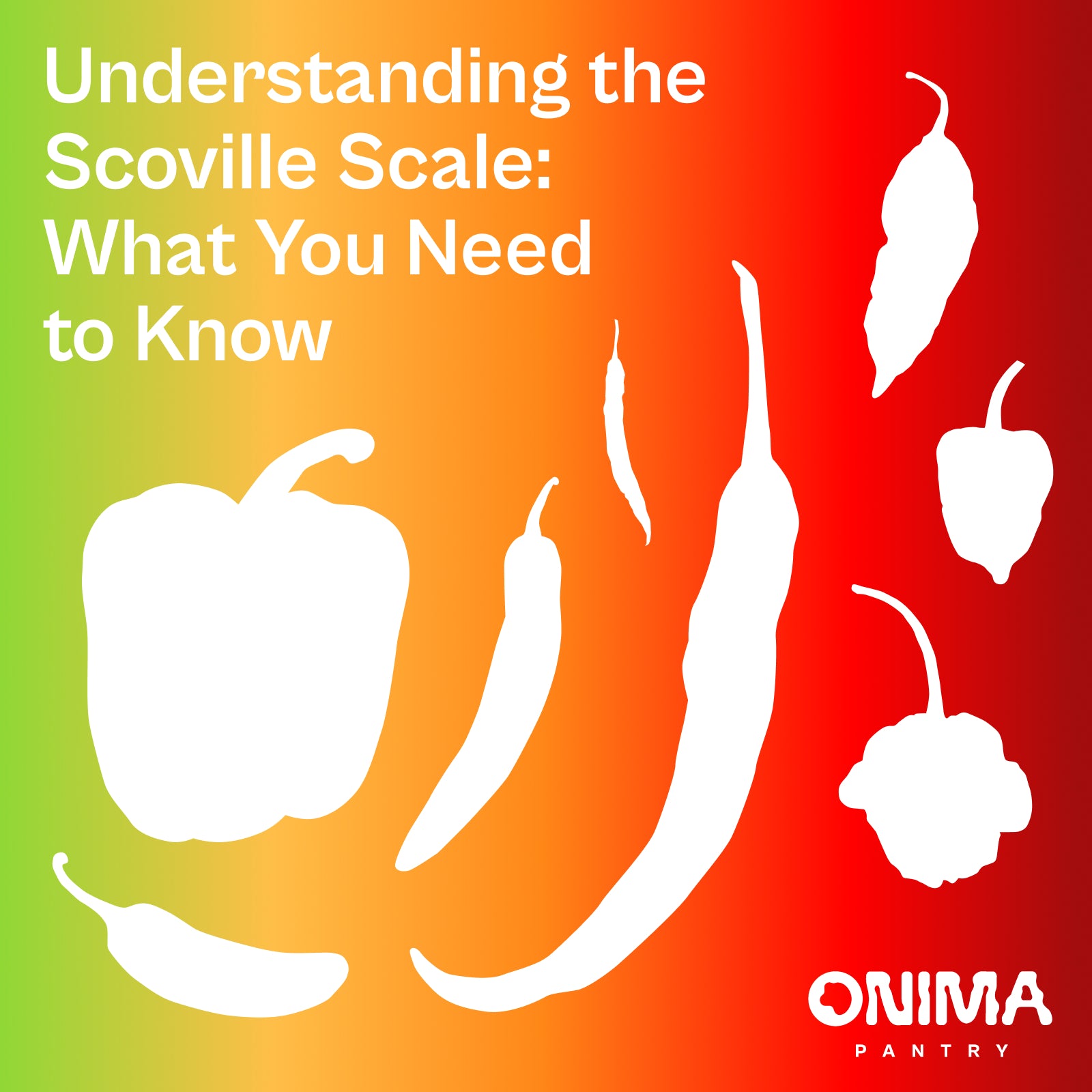Understanding the Scoville Scale: What You Need to Know
What is “Spicy”?
When someone says something tastes spicy, it’s a bit of a misnomer. Spicy isn’t a taste but rather a pain response sent to your brain from polymodal nociceptors in your throat, mouth, and on your tongue. These receptors are triggered by a group of compounds found in chili peppers called capsaicinoids. When the receptors detect capsaicin, they send a signal to your brain that results in a flight or fight response which leads to sweating, tearing up, and increased heart rate. Your brain literally thinks your mouth is on fire.
Not all capsaicinoids are created equal though. Alkylamides found in black pepper and chilis will create an intense mouth burning sensation due to the heavier weight of the molecule whereas foods like wasabi, mustard, and horseradish contain lighter molecules called isothiocyanates. These smaller molecules can easily be aerosolized into your sinus cavity, creating a nose burning sensation.
Okay, so different foods have different degrees of spiciness and can vary dramatically in terms of how that spice affects you. Is there a way to measure spiciness so we can scientifically stay within our preferred range of pain?
The Origins of Scoville
The Scoville Organoleptic Test, or more commonly known as the Scoville Scale, was created in 1912 by Wilbur Lincoln Scoville at Parke-Davis pharmaceutical company while testing the pungency of various chili peppers. Scoville needed to create a system in which he could reliably measure the perceived capsaicin content of chili peppers for use in a pharmaceutical environment.
The Scoville Scale has become the standard way to rate a food’s spiciness. This scale aims to help lovers of spicy foods understand exactly what they are getting themselves into when they take a bite of an intimidating chili pepper.
How the Scoville Scale Works
- Scoville Heat Units (SHU): The hotness of a chili is measured in units known as Scoville Heat Units or SHU for short.
- Testing Methods: There are two primary methods for testing the capsaicin content of peppers: The Scoville Scale and High-Performance Liquid Chromatography (HPLC).
SHU is an acronym referring to Scoville Heat Units which are the units used to measure the “hotness” of a chili. When used in the scale, SHU begin at 0 SHU and increase indefinitely.
In order to compute SHU for a chili, a sample of the pepper is dehydrated and dissolved in alcohol to extract its capsaicinoids before being diluted in sugar water. The concentration is repeatedly diluted in more and more sugar water until a panel of trained tasters can no longer sense any heat in the solution. The final SHU level is then calculated from the amount of dilutions it took to reach a terminal level and ranked in increments of 100 SHU.
Popular Peppers and Their Scoville Ratings
All these numbers can make your head spin without any context grounded in your real life experience. While maybe not all of us have eaten a ghost pepper straight up, most of us have nibbled on a bell pepper, a jalapeño, and maybe even a raw habanero. Here are some examples of how common pepper varieties rank on the Scoville scale.

- Mild Peppers:
- SHU range: 0 - 500 SHU.
- Examples: Bell pepper, Banana pepper.
- Medium Heat Peppers:
- SHU range: 2,500 - 25,000 SHU.
- Examples: Jalapeño, Serrano, Fresno.
- Hot Peppers:
- SHU range: 30,000 - 100,000 SHU.
- Examples: Cayenne, Thai chili.
- Super Hot Peppers:
- SHU range: 100,000 - 500,000 SHU.
- Examples: Habanero, Red Savina, Scotch Bonnet.
- Extremely Hot Peppers:
- SHU range: 500,000 - 2,000,000+ SHU.
- Examples: Ghost Pepper, Scorpion Pepper, Carolina Reaper.
Pepper X is a cultivar bred by hot pepper breeder, Ed Currie who also created the Carolina Reaper. In 2023, Guinness World Records awarded Ed the top spot for the hottest chili in the world with his new Pepper X garnering 2.69 million SHU. There is some debate about the legitimacy of this claim due to testing methodology and farmer politics. Undoubtedly there will be a new king to wear this crown at some point in the future. Pepper X is currently featured on Hot Ones with their The Last Dab: Xperience made by Heatonist and Ed Currie.
The Problem with Scoville
In my opinion, there is a definitive series of issues with the Scoville Scale itself and how it is applied from farm to bottle. Many hot sauce producers have a fundamental misunderstanding of how to state the SHU of a sauce on their label. I completely understand the allure of slapping 1 million Scoville units on the sauce you’ve been working on for years; it’s a great marketing technique. But the reality is that those readings are based on a telephone game of math stemming from a flawed methodology.
Usually what happens is one of the following: Farmer Joe grows a crop of Carolina Reaper, adds some nice spices, maybe some boutique vinegar, maybe he even ferments the chilis before making the sauce. Excited by the prospect of making a “super hot” to blow his buddies away, he googles “Carolina Reaper Scoville Level”. He sees the first result saying 2.2 million SHU and, boom, slaps 2,200,000 MILLION SCOVILLE UNITS on the label. The problem is that reapers range wildly between about 1-2 million SHU. Both the maker and the customer are now misinformed. There is also a critical error in this math we’ll cover in the next example.
Maybe Farmer Joe is a little bit intuitive and understands that okay, I need to take an average SHU reading of the reaper but not only that. I should consider pepper dilution as it relates to the other ingredients. Because Farmer Joe isn’t sending samples out to a lab for testing, he’ll take an average SHU level of 1.6 million then factor in the remaining ingredients for the sauce. If the reapers only make up 40% of the sauce, then the 1.6 million scoville units have now decreased to a whopping 640,000 SHU. This is a little more accurate in communicating to yourself and the customer.
The real problem lies in the testing methodology and dissemination of benchmarked levels. The Scoville Scale is purely sensory based. There is no scientific tool used in measuring actual capsaicinoids. It relies purely on the testers’ tongue and perception of when the spice disappears which is completely affected by mood, physiology, tolerance, and capsaicin fatigue.
Do you suppose all green jalapeños across the world contain the same level of capsaicin? Wrong. An infinite amount of factors not limited to harvest time, geography, climate, sub-varietals, greenhouse or field farming, etc will immensely affect the taste, color, water content, and capsaicin levels of the chili. Using a benchmarked level you find on google is completely fine for a frame of reference but is far from accurate.
Josh Fitzhugh at Josh’s Jungle has an interesting proposition for more accurately measuring heat. You can read his writings here.
An Alternative Method of Measuring Heat
High-Performance Liquid Chromatography (HPLC), applied through the Gillett Method since the 1970s, has become the modern standard for measuring the heat of chili peppers. This technique quantitatively analyzes capsaicinoids by measuring their concentration in parts per million (ppm). The results are typically reported in American Spice Trade Association (ASTA) pungency units, which can be converted to Scoville Heat Units (SHU) using a mathematical conversion factor, generally around 15. The HPLC method is valued for its accuracy and efficiency in identifying and quantifying capsaicinoids, which includes not only capsaicin but also dihydrocapsaicin.
To determine the heat level, HPLC traces the peak areas of capsaicin and dihydrocapsaicin in a dry sample dissolved in acetonitrile. The calculation for parts per million of heat (ppmH) is performed by summing the peak area of capsaicin and 0.82 times the peak area of dihydrocapsaicin, then dividing by the peak area of a standard capsaicin sample. The ppmH value is then multiplied by 15 to obtain the SHU.
Example Calculation
Assume the following data from the HPLC analysis:
- Peak area of capsaicin = 5000
- Peak area of dihydrocapsaicin = 3000
- Peak area of standard = 1000
First, calculate ppmH:

Then, convert ppmH to SHU:

Thus, the sample would be reported as having 111.9 Scoville Heat Units (SHU).
While this method is more precise than the traditional Scoville Organoleptic Test, experts note that it tends to yield results about 20-40% lower than the original test. Despite its precision, the HPLC method focuses primarily on the main capsaicinoids, potentially overlooking other spicy compounds that could also contribute to a pepper's overall heat.
What Does This All Mean?
I’m not really sure what it all means. There is a reason that ONIMA doesn’t focus on the heat level of our sauces until the very end. My approach to sauce design is almost upside down in a way. Each sauce starts with building layers of flavor until it reaches its maturity without the chili. The next goal is to find a chili variety that complements the existing flavors and plays with them in interesting ways. Usually this is achieved through lactic fermentation of the chilis themselves and keeping the base fresh, especially when using fruit.
We use a flavor wheel approach to explaining our sauces. The wheel includes parameters such as bitter, savory, herbal, smoke, acid, citrus, sweet, floral, and of course heat. Not to say we won’t ever put a Scoville rating on our labels as it is a very valuable marketing tool, such as was IBU in the hop wars of the early 2010s, SHU just doesn’t resonate with ONIMA as much as discovering nuance below the heat.

